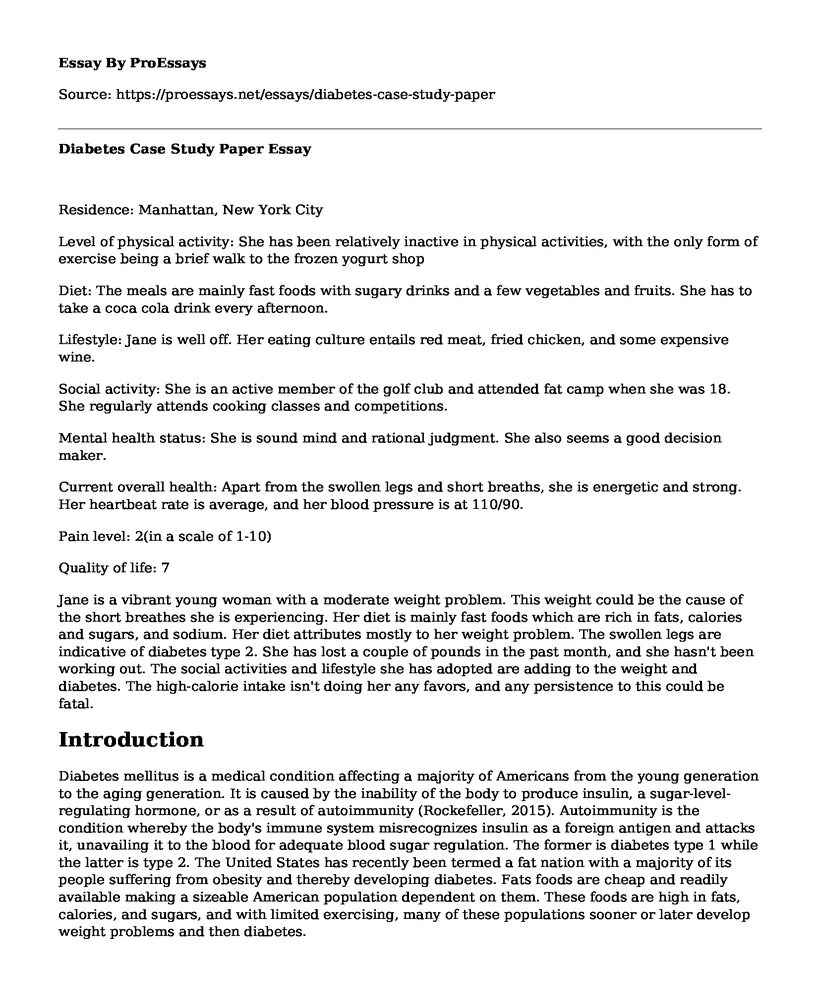Residence: Manhattan, New York City
Level of physical activity: She has been relatively inactive in physical activities, with the only form of exercise being a brief walk to the frozen yogurt shop
Diet: The meals are mainly fast foods with sugary drinks and a few vegetables and fruits. She has to take a coca cola drink every afternoon.
Lifestyle: Jane is well off. Her eating culture entails red meat, fried chicken, and some expensive wine.
Social activity: She is an active member of the golf club and attended fat camp when she was 18. She regularly attends cooking classes and competitions.
Mental health status: She is sound mind and rational judgment. She also seems a good decision maker.
Current overall health: Apart from the swollen legs and short breaths, she is energetic and strong. Her heartbeat rate is average, and her blood pressure is at 110/90.
Pain level: 2(in a scale of 1-10)
Quality of life: 7
Jane is a vibrant young woman with a moderate weight problem. This weight could be the cause of the short breathes she is experiencing. Her diet is mainly fast foods which are rich in fats, calories and sugars, and sodium. Her diet attributes mostly to her weight problem. The swollen legs are indicative of diabetes type 2. She has lost a couple of pounds in the past month, and she hasn't been working out. The social activities and lifestyle she has adopted are adding to the weight and diabetes. The high-calorie intake isn't doing her any favors, and any persistence to this could be fatal.
Introduction
Diabetes mellitus is a medical condition affecting a majority of Americans from the young generation to the aging generation. It is caused by the inability of the body to produce insulin, a sugar-level-regulating hormone, or as a result of autoimmunity (Rockefeller, 2015). Autoimmunity is the condition whereby the body's immune system misrecognizes insulin as a foreign antigen and attacks it, unavailing it to the blood for adequate blood sugar regulation. The former is diabetes type 1 while the latter is type 2. The United States has recently been termed a fat nation with a majority of its people suffering from obesity and thereby developing diabetes. Fats foods are cheap and readily available making a sizeable American population dependent on them. These foods are high in fats, calories, and sugars, and with limited exercising, many of these populations sooner or later develop weight problems and then diabetes.
The young population has exhibited some diabetes type 2 as a result of the overconsumption of cookies and other sugary snacks. In the spirit of overweight being linked to diabetes, these populations are so dependent on fast foods, the likes of pizza, fries, and hamburgers. Women are also affected especially in their mid-ages. African American women come from a culture of unhealthy eating, and the feminine tie to the kitchen(Rockefeller, 2015). They form a 15% of the total diabetes population. Most of these women on the 50s develop glucose intolerance like any other 50-year old, but their bodies quickly convert this intolerance to diabetes. An estimation of about 7.2 million Americans have diabetes, and some do not have a clue that they do.
How would I know I have diabetes? Well, this metabolic condition has profound and well-defined signs and symptoms. These symptoms include:
- Increased and frequent urine output
- Excessive thirst
- Fatigue
- Involuntary weight loss
- Toes and feet numbness
- Skin inflammation
- Burry eyesight
- A persistent feeling of hunger
These signs may be victim-specific, and therefore one may exhibit one symptom and miss on the other. Some of these symptoms may appear to be healthy to an individual and are therefore not a reliable source for diagnosing the condition. Blood tests like the A1C are the most reliable, accurate and valid ways to diagnose it.
The cure for diabetes has for long been a challenge to experts and specialists, and the closest they have come to this is preventing or controlling it. Diabetes supplements trigger an immediate reduction in sugar levels and blood glucose intake enabling the tissues to take in more glucose from the blood (Haw et al., 2017). They can also cause an elevation in insulin sensitivity thereby resulting in regulation in blood sugar levels. These supplements include green tea, magnesium, cinnamon, chromium and alpha-lipoic acid. Prevention can consist of regular exercising, eating healthy meals with low calories and sugars, and having plenty fiber. An apple a day keep the doctor away.
References
Haw J.S., Galaviz K.I., Straus A.N., Kowalski A.J., Magee M.J., Weber M.B., Wei J, Narayan K.M. & Ali M.K. (2017). "Long-term Sustainability of Diabetes Prevention Approaches: A Systematic Review and Meta-analysis of Randomized Clinical Trials". JAMA Internal Medicine. 177 (12): 1808-1817
Rockefeller, J. D. (2015). Diabetes: Symptoms, Causes, Treatment and Prevention. ISBN 9781514603055. Archived from the original on 2017-09-06.
Cite this page
Diabetes Case Study Paper. (2022, Jun 06). Retrieved from https://proessays.net/essays/diabetes-case-study-paper
If you are the original author of this essay and no longer wish to have it published on the ProEssays website, please click below to request its removal:
- Paper Example on Education and Support from the ACS
- The Scale of America's Opioid Epidemic Is Shocking
- Nutrition Reflection Paper Example
- Utilitarianism and Illegal Abortions Essay Example
- Leadership and Management in Nursing E-Portfolio
- Essay Sample on Nola Pender's HPM: External and Internal Cues for Nurse Practitioners
- End-of-Life Care: Ethical Issues & Medical Futility - Essay Sample







